Comprehensive Model for Evaluating the Performance of Mach-Zehnder-Based Silicon Photonic Switch Fabrics in Large Scale
Abstract
1. Introduction
2. Performance Limitations of LS-MZS
2.1. Insertion Loss
2.2. Optical Crosstalk
3. Large-Scale Photonic Switch Architectures
4. Analytical Model: Signal-to-Crosstalk Ratio
4.1. Signal-to-Crosstalk Ratio Model
4.2. Cumulative Crosstalk Power Terms
5. Architecture Comparison
6. MZI and Waveguide Crossing Characteristics
7. Discussion
Author Contributions
Funding
Conflicts of Interest
Appendix A

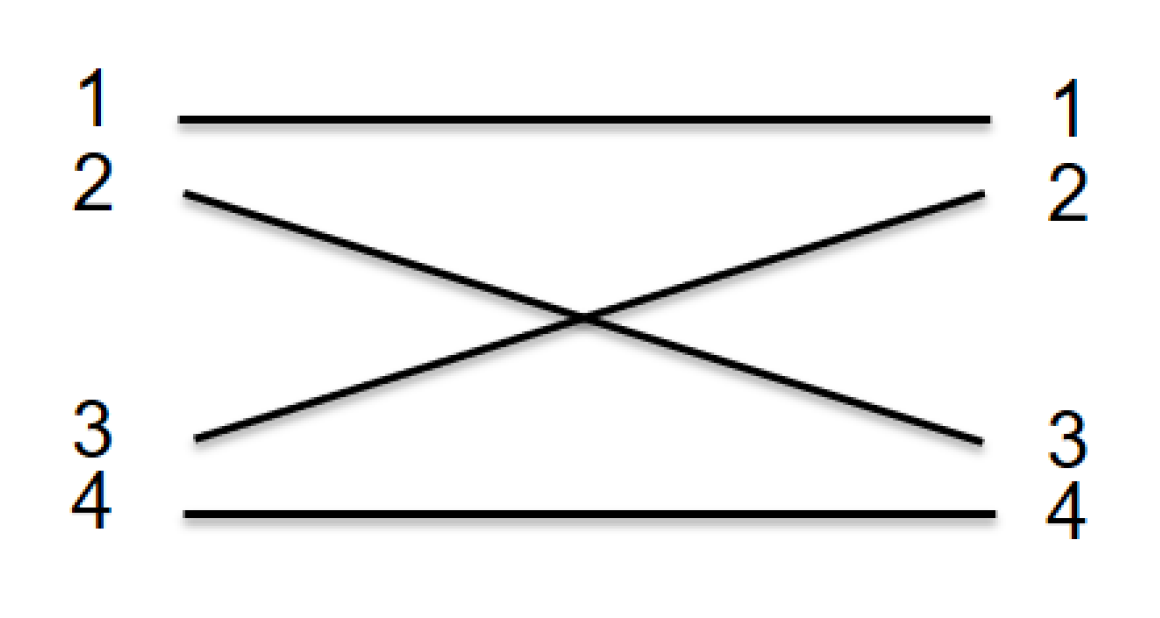
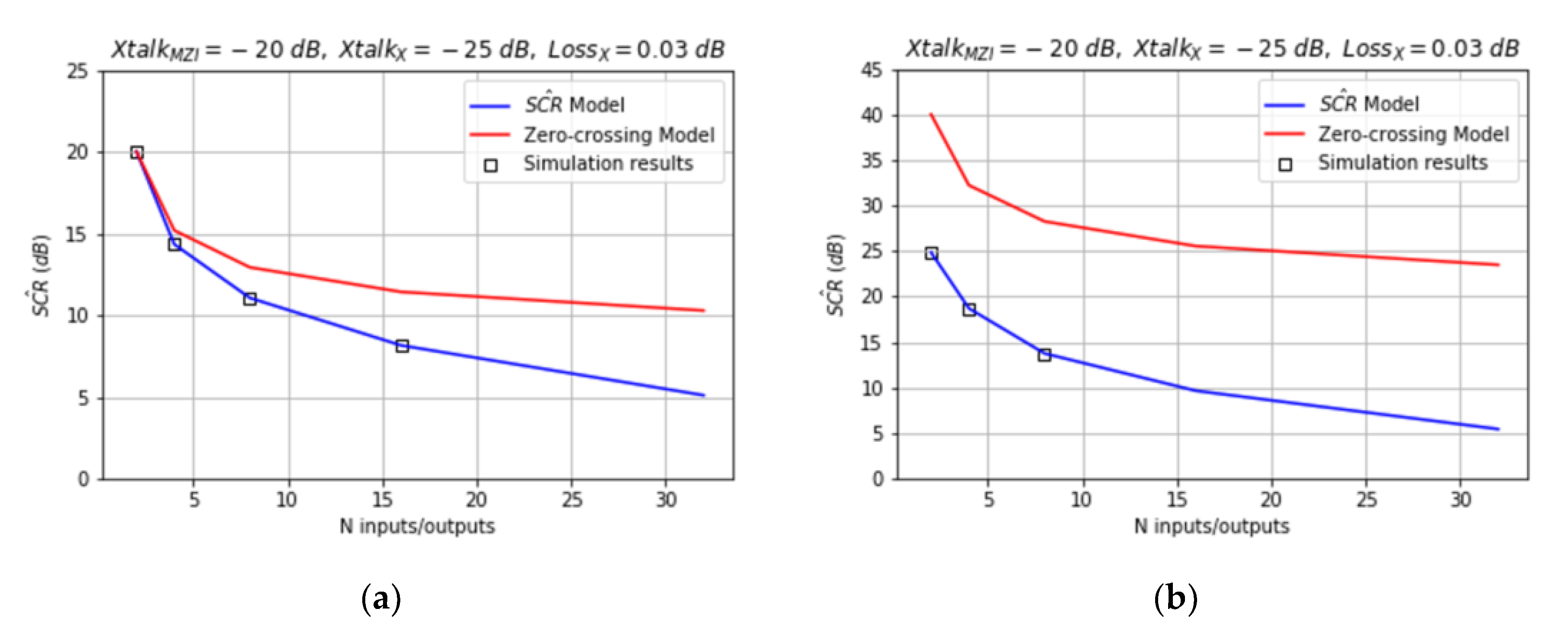
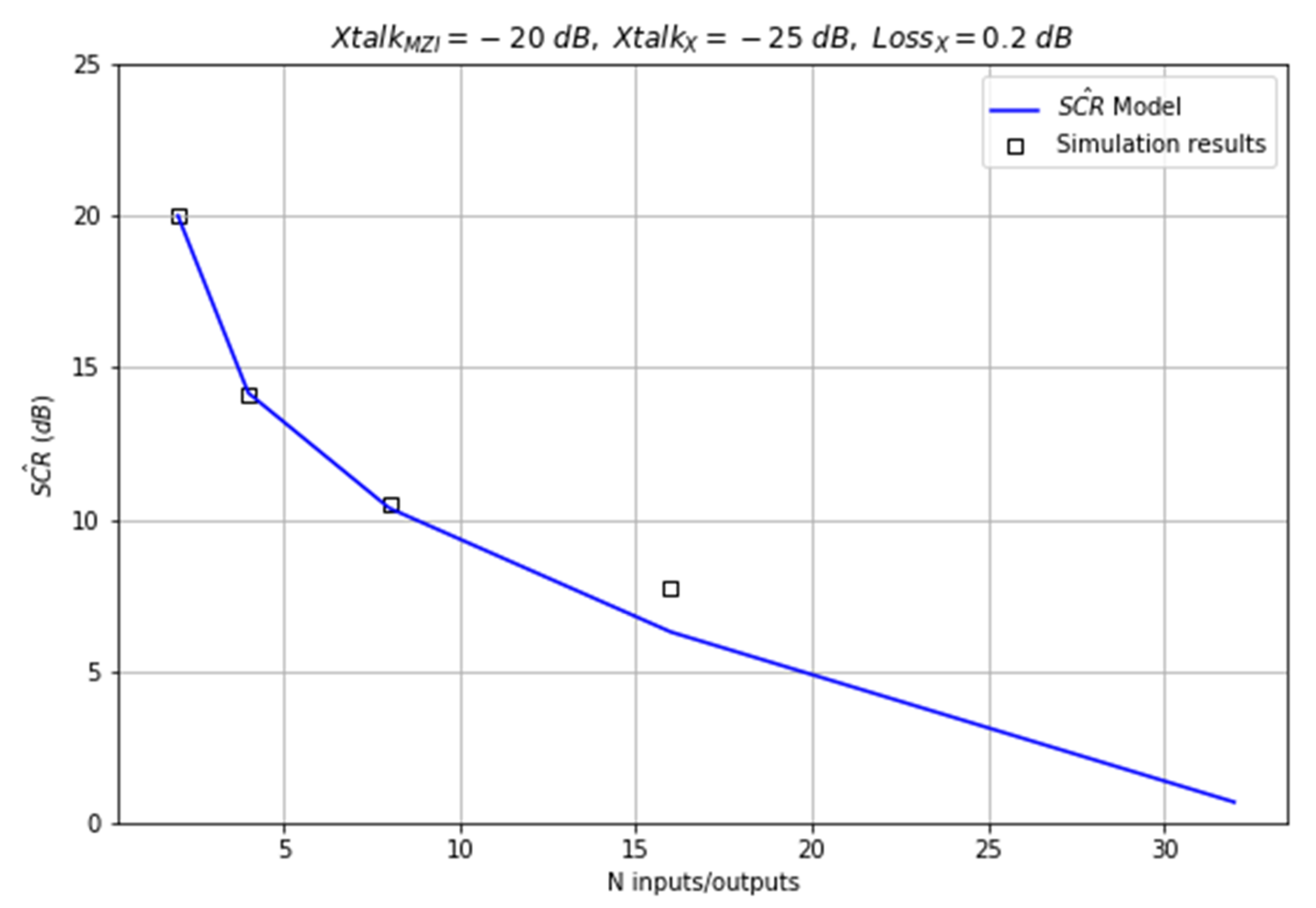
References
- Kachris, C.; Bergman, K.; Tomkos, I. Introduction to Optical Interconnects in Data Centers. In Optical Interconnects for Future Data Center Networks; Kachris, C., Bergman, K., Tomkos, I., Eds.; Optical Networks; Springer: New York, NY, USA, 2013; pp. 3–13. [Google Scholar] [CrossRef]
- Bergman, K.; Carloni, L.P.; Biberman, A.; Chan, J.; Hendry, G. Photonic Network-on-Chip Design; Integrated Circuits and Systems; Springer: New York, NY, USA, 2014. [Google Scholar]
- Tu, X.; Song, C.; Huang, T.; Chen, Z.; Fu, H. State of the Art and Perspectives on Silicon Photonic Switches. Micromachines 2019, 10, 51. [Google Scholar] [CrossRef]
- Xie, Y.; Zhang, M.; Dai, D. Design Rule of Mach-Zehnder Interferometer Sensors for Ultra-High Sensitivity. Sensors 2020, 20, 2640. [Google Scholar] [CrossRef]
- Qiao, L.; Tang, W.; Chu, T. Ultra-Large-Scale Silicon Optical Switches. In Proceedings of the 2016 IEEE 13th International Conference on Group IV Photonics (GFP), Shanghai, China, 24–26 August 2016; pp. 1–2. [Google Scholar] [CrossRef]
- Dupuis, N.; Doany, F.; Budd, R.A.; Schares, L.; Baks, C.W.; Kuchta, D.M.; Hirokawa, T.; Lee, B.G. A Nonblocking 4 × 4 Mach-Zehnder Switch with Integrated Gain and Nanosecond-Scale Reconfiguration Time. In Proceedings of the 2019 Optical Fiber Communications Conference and Exhibition (OFC), San Diego, CA, USA, 3–7 March 2019; pp. 1–3. [Google Scholar]
- Lee, B.G.; Dupuis, N.; Pepeljugoski, P.; Schares, L.; Budd, R.; Bickford, J.R.; Schow, C.L. Silicon Photonic Switch Fabrics in Computer Communications Systems. J. Lightwave Technol. 2015, 33, 768–777. [Google Scholar] [CrossRef]
- Dupuis, N.; Lee, B.G. Impact of Topology on the Scalability of Mach–Zehnder-Based Multistage Silicon Photonic Switch Networks. J. Lightwave Technol. 2018, 36, 763–772. [Google Scholar] [CrossRef]
- Cheng, Q.; Bahadori, M.; Glick, M.; Rumley, S.; Bergman, K. Recent Advances in Optical Technologies for Data Centers: A Review. Optica 2018, 5, 1354–1370. [Google Scholar] [CrossRef]
- Suzuki, K.; Konoike, R.; Suda, S.; Matsuura, H.; Namiki, S.; Kawashima, H.; Ikeda, K. Low-Loss, Low-Crosstalk, and Large-Scale Optical Switch Based on Silicon Photonics. J. Lightwave Technol. 2019. [Google Scholar] [CrossRef]
- Dupuis, N.; Lee, B.G.; Rylyakov, A.V.; Kuchta, D.M.; Baks, C.W.; Orcutt, J.S.; Gill, D.M.; Green, W.M.J.; Schow, C.L. Design and Fabrication of Low-Insertion-Loss and Low-Crosstalk Broadband 2 × 2 Mach–Zehnder Silicon Photonic Switches. J. Lightwave Technol. 2015, 33, 3597–3606. [Google Scholar] [CrossRef]
- Soref, R.; Bennett, B. Electrooptical Effects in Silicon. IEEE J. Quantum Electron. 1987, 23, 123–129. [Google Scholar] [CrossRef]
- Beneš, V.E. Mathematics in Science and Engineering | Mathematical Theory of Connecting Networks and Telephone Traffic; Academic Press: New York, NY, USA, 1965. [Google Scholar]
- Padmanabhan, K.; Netravali, A. Dilated Networks for Photonic Switching. IEEE Trans. Commun. 1987, 35, 1357–1365. [Google Scholar] [CrossRef]
- Lu, C.-C.; Thompson, R.A. The Double-Layer Network Architecture for Photonic Switching. J. Lightwave Technol. 1994, 12, 1482–1489. [Google Scholar] [CrossRef]
- Spanke, R. Architectures for Large Nonblocking Optical Space Switches. IEEE J. Quantum Electron. 1986, 22, 964–967. [Google Scholar] [CrossRef]
- Kabacinski, W. Modified Dilated Benes Networks for Photonic Switching. IEEE Trans. Commun. 1999, 47, 1253–1259. [Google Scholar] [CrossRef]
- Qian, Y.; Mehrvar, H.; Ma, H.; Yang, X.; Zhu, K.; Fu, H.Y.; Geng, D.; Goodwill, D.; Dumais, P.; Bernier, E. Crosstalk Optimization in Low Extinction-Ratio Switch Fabrics. In Proceedings of the 2014 Optical Fiber Communications Conference and Exhibition (OFC), San Diego, CA, USA, 9–13 March 2014; pp. 1–3. [Google Scholar] [CrossRef]
- Zhang, Y.; Yang, S.; Lim, A.E.; Lo, G.; Galland, C.; Baehr-Jones, T.; Hochberg, M. A CMOS-Compatible, Low-Loss, and Low-Crosstalk Silicon Waveguide Crossing. IEEE Photonics Technol. Lett. 2013, 25, 422–425. [Google Scholar] [CrossRef]
- Sanchis, P.; Galan, J.V.; Brimont, A.; Griol, A.; Marti, J.; Piqueras, M.A.; Perdigues, J.M. Low-Crosstalk in Silicon-on-Insulator Waveguide Crossings with Optimized-Angle. IEEE Photonics Technol. Lett. 2007, 19, 1583–1585. [Google Scholar] [CrossRef]
- Dumais, P.; Goodwill, D.J.; Celo, D.; Jiang, J.; Bernier, E. Three-Mode Synthesis of Slab Gaussian Beam in Ultra-Low-Loss in-Plane Nanophotonic Silicon Waveguide Crossing. In Proceedings of the 2017 IEEE 14th International Conference on Group IV Photonics (GFP), Berlin, Germany, 23–25 August 2017; pp. 97–98. [Google Scholar] [CrossRef]
- Dupuis, N.; Proesel, J.E.; Ainspan, H.; Baks, C.W.; Meghelli, M.; Lee, B.G. Nanosecond Photonic Switch Architectures Demonstrated in an All-Digital Monolithic Platform. Opt. Lett. 2019, 44, 3610–3612. [Google Scholar] [CrossRef] [PubMed]
- Kouissi, M.; Charbonnier, B.; Algani, C. Fast 2×2 Mach-Zehnder Switch for Optical Interconnect Applications. Opt. Soc. Am. 2020, PsTh2F.5. [Google Scholar] [CrossRef]



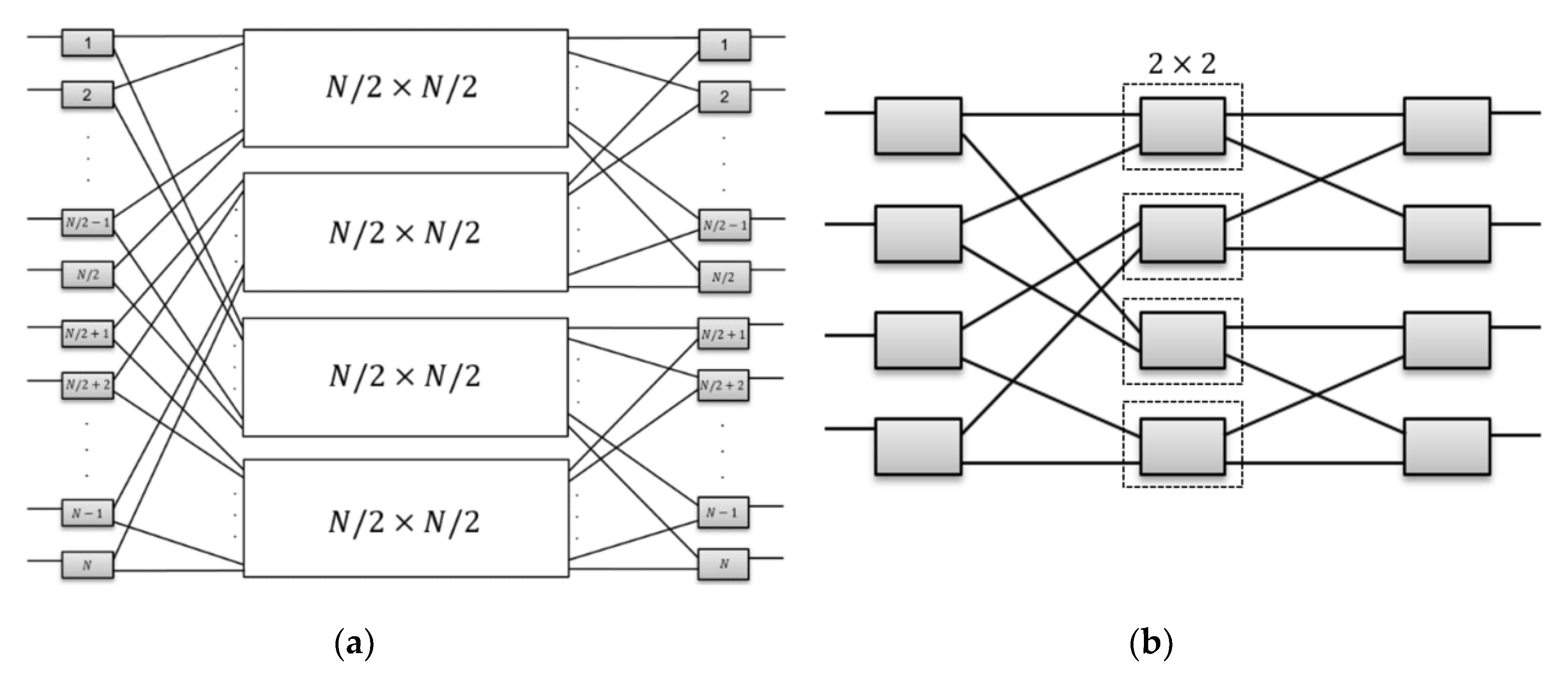
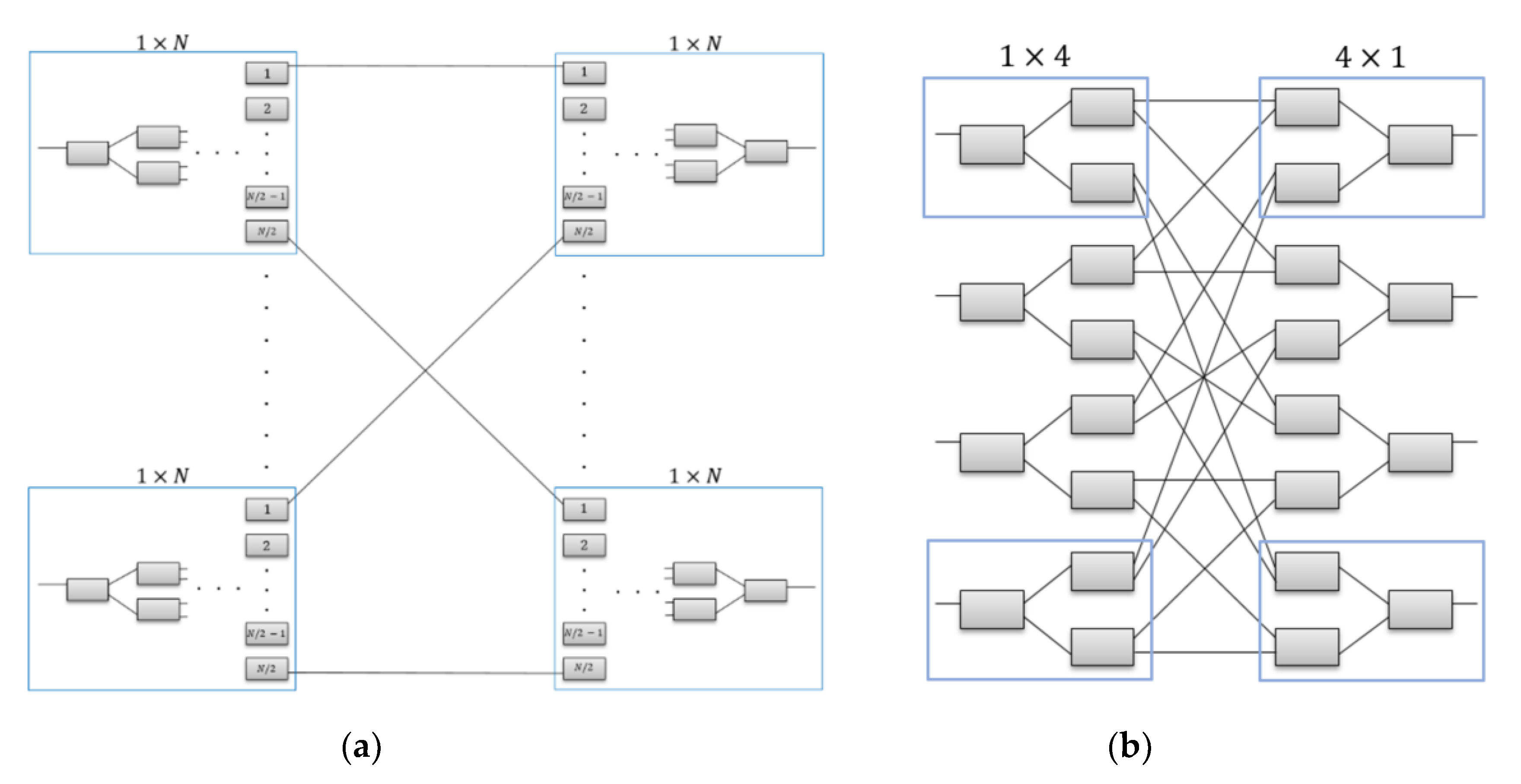

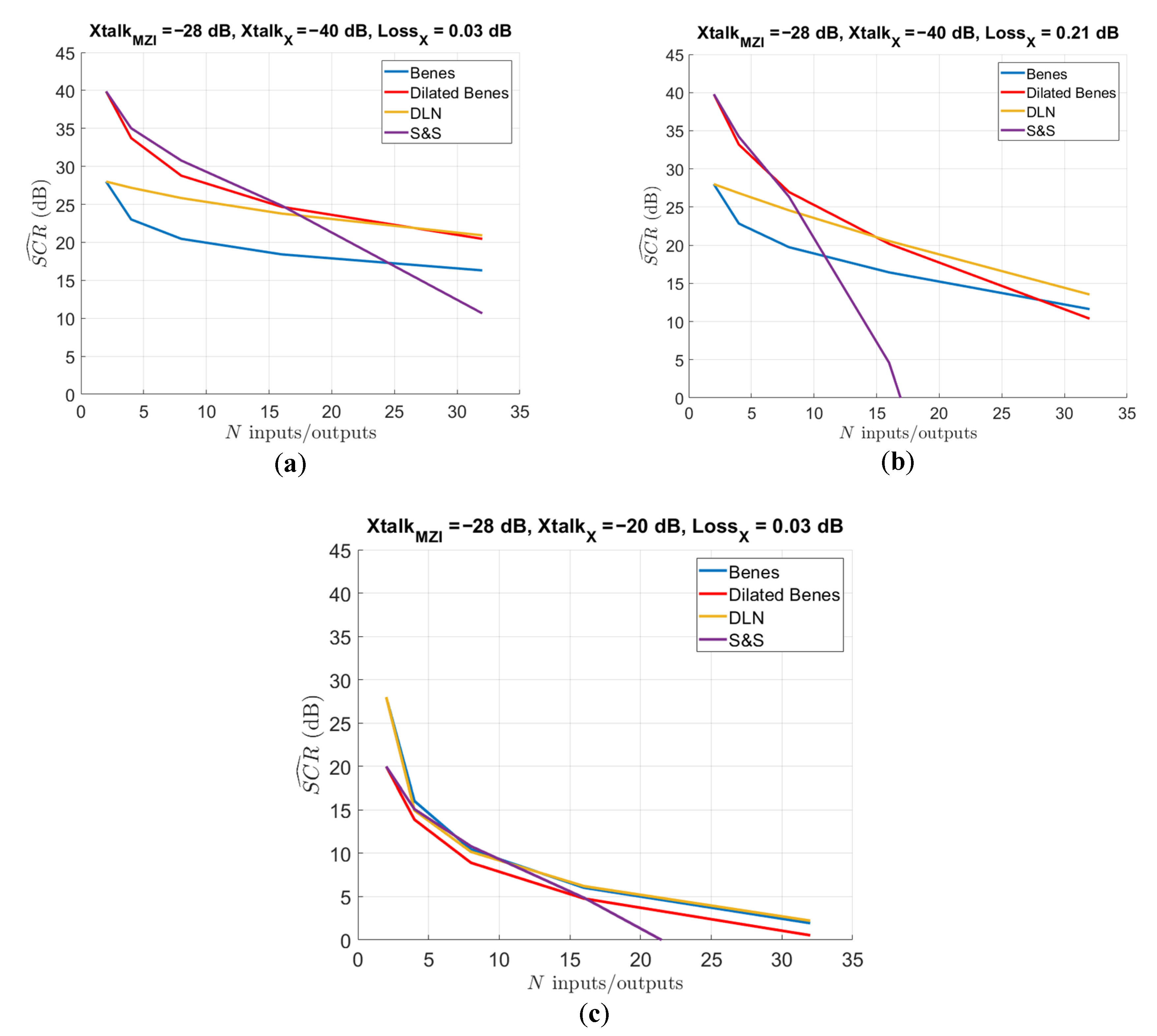

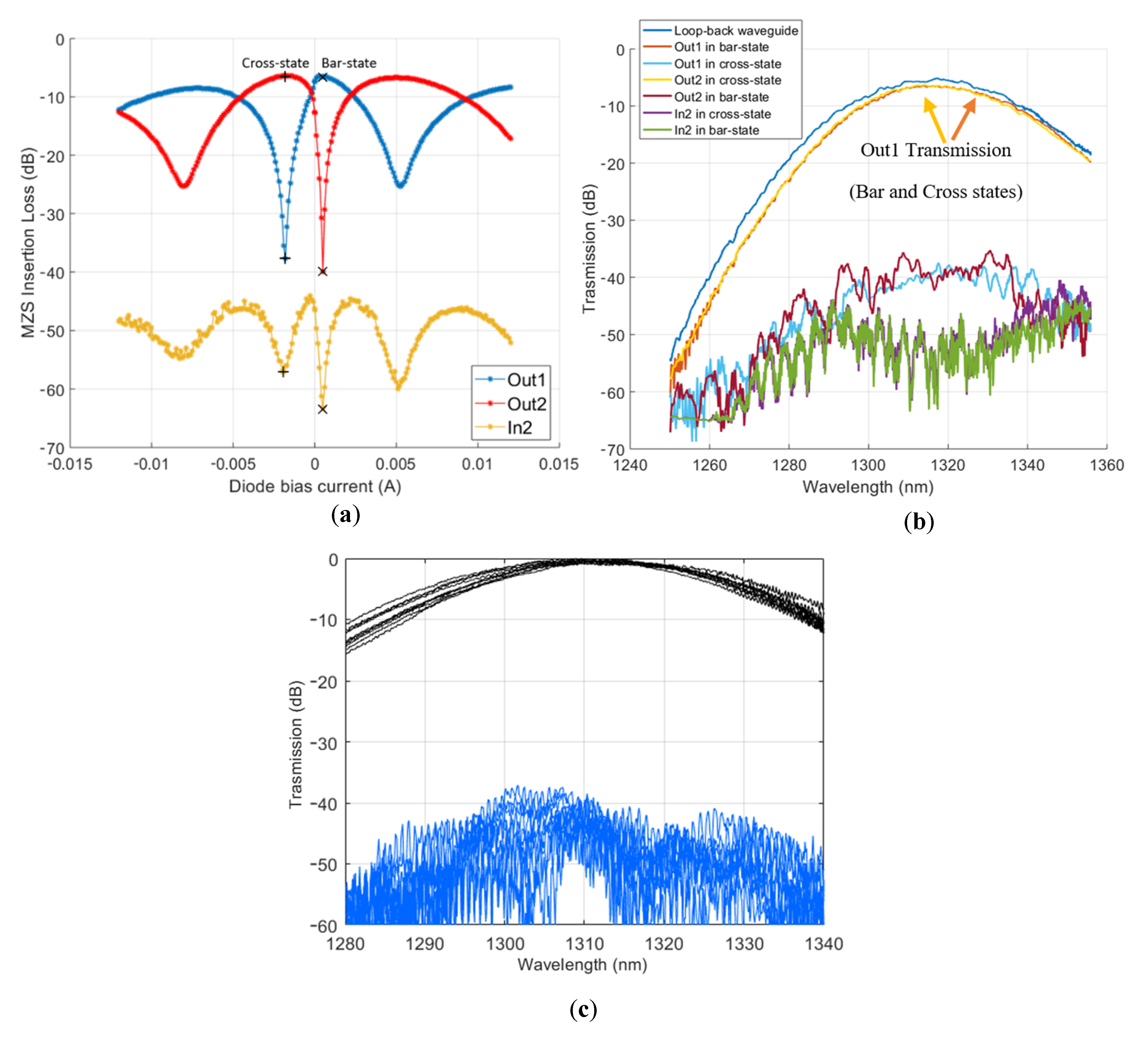
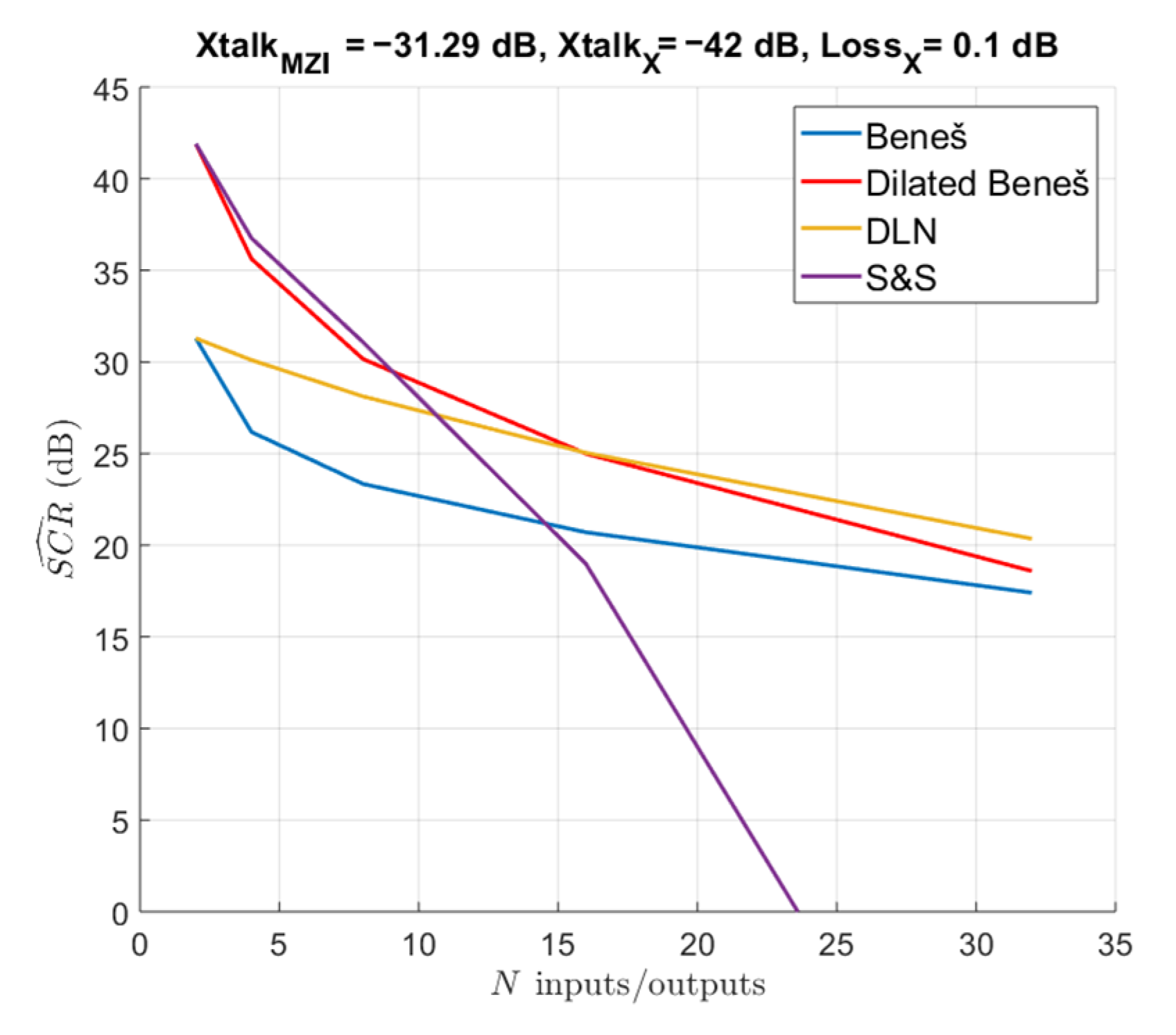
| Stage Count | W. Crossing Count | |
|---|---|---|
| Beneš | ||
| Dilated Beneš | ||
| DLN | ||
| S&S |
| Input and Path Number | After S1 | After S2 | After S3 |
|---|---|---|---|
| Beneš | ||
| Dilated Beneš | ||
| DLN | ||
| S&S |
| Metric | Value |
|---|---|
| Waveguide crossing loss | 0.1 dB |
| Waveguide crossing crosstalk ( | <−42 dB |
| MZI Loss ( | 1.31 dB |
| MZI Crosstalk ( | −31.3 dB |
Publisher’s Note: MDPI stays neutral with regard to jurisdictional claims in published maps and institutional affiliations. |
© 2020 by the authors. Licensee MDPI, Basel, Switzerland. This article is an open access article distributed under the terms and conditions of the Creative Commons Attribution (CC BY) license (http://creativecommons.org/licenses/by/4.0/).
Share and Cite
Kouissi, M.; Charbonnier, B.; Algani, C. Comprehensive Model for Evaluating the Performance of Mach-Zehnder-Based Silicon Photonic Switch Fabrics in Large Scale. Appl. Sci. 2020, 10, 8688. https://doi.org/10.3390/app10238688
Kouissi M, Charbonnier B, Algani C. Comprehensive Model for Evaluating the Performance of Mach-Zehnder-Based Silicon Photonic Switch Fabrics in Large Scale. Applied Sciences. 2020; 10(23):8688. https://doi.org/10.3390/app10238688
Chicago/Turabian StyleKouissi, Marouan, Benoit Charbonnier, and Catherine Algani. 2020. "Comprehensive Model for Evaluating the Performance of Mach-Zehnder-Based Silicon Photonic Switch Fabrics in Large Scale" Applied Sciences 10, no. 23: 8688. https://doi.org/10.3390/app10238688
APA StyleKouissi, M., Charbonnier, B., & Algani, C. (2020). Comprehensive Model for Evaluating the Performance of Mach-Zehnder-Based Silicon Photonic Switch Fabrics in Large Scale. Applied Sciences, 10(23), 8688. https://doi.org/10.3390/app10238688




